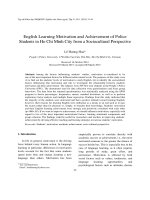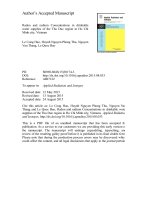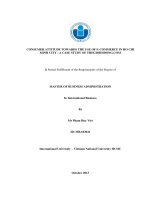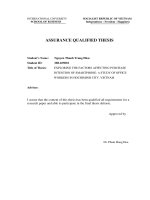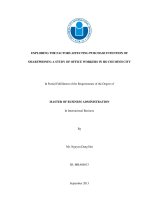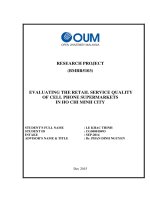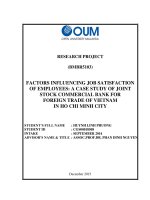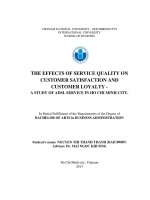Exploring the factors affecting purchase intention of smartphone a study of office workers in ho chi minh city, vietnam
Bạn đang xem bản rút gọn của tài liệu. Xem và tải ngay bản đầy đủ của tài liệu tại đây (1.03 MB, 84 trang )
INTERNATIONAL UNIVERSITY
SCHOOL OF BUSINESS
SOCIALIST REPUBLIC OF VIETNAM
Independence - Freedom - Happiness
ASSURANCE QUALIFIED THESIS
Student’s Name:
Nguyen Thanh Trung Hieu
Student ID:
MBA05010
Title of Thesis:
EXPLORING THE FACTORS AFFECTING PURCHASE
INTENTION OF SMARTPHONE: A STUDY OF OFFICE
WORKERS IN HOCHIMINH CITY, VIETNAM
Advisor:
I assure that the content of this thesis has been qualified all requirements for a
research paper and able to participate in the final thesis defense.
Approved by
Dr. Pham Hong Hoa
EXPLORING THE FACTORS AFFECTING PURCHASE INTENTION OF
SMARTPHONE: A STUDY OF OFFICE WORKERS IN HOCHIMINH
CITY, VIETNAM
In Partial Fulfillment of the Requirements of the Degree of
MASTER OF BUSINESS ADMINISTRATION
In Marketing
By
Mr. Nguyen Thanh Trung Hieu
ID: MBA05010
International University - Vietnam National University HCMC
September 2014
EXPLORING THE FACTORS AFFECTING PURCHASE INTENTION OF
SMARTPHONE: A STUDY OF OFFICE WORKERS IN HOCHIMINH CITY,
VIETNAM
In Partial Fulfillment of the Requirements of the Degree of
MASTER OF BUSINESS ADMINISTRATION
In Marketing
by
Mr. Nguyen Thanh Trung Hieu
ID: MBA05010
International University - Vietnam National University HCMC
September 2014
Under the guidance and approval of the committee, and approved by all its members,
this thesis has been accepted in partial fulfillment of the requirements for the degree.
Approved:
---------------------------------------------Chairperson
--------------------------------------------Advisor: Dr. Pham Hong Hoa
----------------------------------------------
---------------------------------------------
Committee member
---------------------------------------------Committee member
Committee member
--------------------------------------------Committee member
Acknowledge
This study would not have been completed without the kind guidance and the support
of my supervisor, my family and friends.
First of all, I would like to express my profound gratitude and appreciation to my
supervisor Dr. Pham Hong Hoa for her valuable guidance, advices and
recommendations throughout this research. Thank you for your kind support every
time I am in need for consultation.
I would like to express my great appreciation to all the teachers of the Master‟s
program in the International University, who imparted their knowledge and
experience to me during the past two years.
I would like to give special thanks to my beloved family which has been my
inspiration throughout the past time and always been the endless source of joy in my
life.
It is also my pleasure to have the opportunity to study with classmates from
MBAIU05 who have shared with me their impressive knowledge and skills during the
challenging courses of the MBA program.
Finally, I would like to thank the members of the Examination Committee for taking
time and giving valuable comments so that I could improve this thesis.
Plagiarism Statements
I would like to declare that, apart from the acknowledged references, this
thesis either does not use language, ideas, or other original material from anyone; or
has not been previously submitted to any other educational and research programs or
institutions. I fully understand that any writings in this thesis contradicted to the
above statement will automatically lead to the rejection from the MBA program at the
International University – Vietnam National University Ho Chi Minh City.
Copyright Statement
This copy of the thesis has been supplied on condition that anyone who consults it is
understood to recognize that its copyright rests with its author and that no quotation
from the thesis and no information derived from it may be published without the
author‟s prior consent.
© Nguyen Thanh Trung Hieu/MBA05010/2011-2014
Table of Contents
Chapter 1.
Introduction ............................................................................................................... 1
1.1
Research Background....................................................................................................... 1
1.2
Research Problems .......................................................................................................... 2
1.3
Research Questions ......................................................................................................... 3
1.4
Research Objectives ......................................................................................................... 3
1.5
Research scope and limitation ......................................................................................... 3
1.6
Significant of the Research .............................................................................................. 4
1.7
Research Methodology .................................................................................................... 4
1.8
Structure of Research ...................................................................................................... 6
1.8.1
Chapter One: Introduction ......................................................................................... 6
1.8.2
Chapter Two: Literature review ................................................................................. 6
1.8.3
Chapter Three: Research Methodology ..................................................................... 6
1.8.4
Chapter Four: Data Analysis and Findings .................................................................. 6
1.8.5
Chapter Five: Conclusion............................................................................................ 6
Chapter 2.
Literature Review ....................................................................................................... 7
2.1
Dependent Variable ......................................................................................................... 7
2.1.1
2.2
Purchase Intention ...................................................... Error! Bookmark not defined.
Independent variable ....................................................................................................... 8
2.2.1
Price............................................................................................................................ 8
2.2.2
Brand ........................................................................................................................ 10
2.2.3
Compatibility ............................................................................................................ 10
2.2.4
Product Feature ....................................................................................................... 11
2.2.5
Relative Advantage .................................................................................................. 12
2.2.6
Social Influences ....................................................................................................... 13
2.3
Review of relevant theory.............................................................................................. 13
2.3.1
Diffusion of innovations ........................................................................................... 13
2.3.2
Social Identity Theory............................................................................................... 15
2.3.3
Theory of Materialism .............................................................................................. 15
2.4
Proposed Theoretical Framework.................................................................................. 17
2.5
Hypothesis Development ............................................................................................... 17
Chapter 3.
Methodology ............................................................................................................ 19
3.1
Research design ............................................................................................................. 19
3.2
Data collection methods ................................................................................................ 19
3.2.1
Primary data ............................................................................................................. 19
3.2.2
Secondary data......................................................................................................... 20
3.2.3
Sampling design ....................................................................................................... 20
3.2.4
Sampling Technique ................................................................................................. 21
3.2.5
Research instrument ................................................................................................ 22
3.3
Data analysis .................................................................................................................. 26
3.3.1
Descriptive statistics................................................................................................. 26
3.3.2
Reliability test ........................................................................................................... 26
3.3.3
Exploratory factor analysis (EFA) ............................................................................. 27
3.3.4
Pearson Correlation Coefficient Test ....................................................................... 27
3.3.5
Multiple regression analysis ..................................................................................... 27
Chapter 4.
DATA ANALYISIS AND Findings ................................................................................. 29
4.1
Sample description ........................................................................................................ 29
4.1.1
Sample ...................................................................................................................... 29
4.1.2
Demographic profile ................................................................................................ 29
4.2
Descriptive statistics ...................................................................................................... 33
4.3
Cronbach’s alpha reliability test .................................................................................... 36
4.4
Exploratory Factor Analysis (EFA) .................................................................................. 39
4.5
Pearson Correlation Coefficient ..................................................................................... 43
4.6
Multiple Regression Analysis ......................................................................................... 45
4.7
Test of Hypothesis.......................................................................................................... 47
Chapter 5.
CONCLUSION ............................................................................................................ 51
5.1
Conclusion ...................................................................................................................... 51
5.2
Practical implication ....................................................................................................... 53
5.3
Limitation and further recommendation ....................................................................... 53
Table 1 - Coded items of measurement scale ................................................................... 26
Table 2 - Rules of Thumb about Correlation Coefficient ................................................. 27
Table 3 - Demographic of Respondents............................................................................ 30
Table 4 - Crosstab between age and average income of respondents ............................... 32
Table 5 – Descriptive statistics of respondents ................................................................. 34
Table 6 - Cronbach's Alpha rule based on George and Mallery ....................................... 36
Table 7 - Reliability test for consumer‟s Purchase Intention on smartphone ................... 37
Table 8 – Reliability test of Brand (1st run) ...................................................................... 38
Table 9 - Reliability test of Brand (2nd run) ...................................................................... 38
Table 10 - Reliability test of Brand (3rd run) .................................................................... 39
Table 11 - The final table of Cronbach‟s alpha reliability test ......................................... 39
Table 12 – Exploratory Factor Analysis (EFA) for independent variables ...................... 41
Table 13 – Group of EFA ................................................................................................. 42
Table 14 – Exploratory Factor Analysis (EFA) for independent variables ...................... 43
Table 15 - Pearson Correlation Testing ............................................................................ 44
Table 16 - Multiple regression testing .............................................................................. 47
Table 17 - Reliability Test of Respondents....................................................................... 71
Figure 1 - Diffusion of innovations model. Rogers, E.M. (1995) .................................... 14
Figure 2 - Conceptual model: Factors affect Purchase Intention of smartphone .............. 17
Figure 3 - Sex of Respondents .......................................................................................... 30
Figure 4 - Age of Respondents ......................................................................................... 31
Figure 5 - Average income of respondents ....................................................................... 31
Abstract
In a world of digital devices, people require more convenient and powerful gadgets on
hand to support for their daily works as well as their need for entertainment.
Smartphone is invented to fulfill those demands, furthermore, provided a most
compact assistant in the pocket. While replace some simple task of work from the
traditional computers, smartphone also play a vital role in people‟s lifestyle. This
leads to a booming in the smartphone industry while more and more people want to
own one smartphone. Nevertheless, it is a fact that there are too many brand of
smartphone found at the current, making the process of choosing a smartphone
become more complicated.
The study aim to explore the factors affecting Purchase Intention of smartphone
among the office workers in Hochiminh City. The initial factors include: Price, Brand,
Relative Advantage, Compatibility, Product Features, Social Influence and Purchase
Intention. 218 respondents have provided data for the study. The process of collecting
is online surveys via the Qualtrics electronic form using likert scale. The data was
analyzed through SPSS 20. The results of this research were unhide base on
answering the research questions.
CHAPTER 1. INTRODUCTION
1.1
Research Background
Since the introduction of 1st IPhone generation, the consumer has inherited a rapid
innovation by smartphone manufacturers. Nowadays, smartphone is considered as a
must-have stuff by most urban persons. Thanks to its fabulous features, smartphone
users may experience things out of communicating: browsing webs, enjoying medias,
playing games, checking emails, using as a navigator, participating in social sites and
so on (Qiang Xu, 2011). In the other hands, smartphone is also named as an "indicator
of status, prestige and lifestyle" (Mohd Azam Osman, 2012). That leads to a trend of
switching from feature phone to smartphone.
It is a normal sense to see one working at office using a smartphone checking their
emails, reading feeds on their Facebook. From a C.E.O to an apprentice, they all
maintain a regularly online status throughout a day with office Wifi or broadband cell
signal. A recent survey conducted by Google an Ipsos Media CT in Vietnam (2013)
indicated that: 70 percent of interviewees using their smartphone daily in past seven
days, while 91 percent of them use their smartphone at works, meanwhile, 58 percent
spent more time online with their smartphone in the last 6 months (Google – Our
mobile planet: Vietnam, quarter 3, 2013). Hence, smartphone is transforming the
consumer behaviors.
Nevertheless, a huge number of manufacturers in the smartphone industry, creates
plenty of models, lead to an embarrassment of consumer while choosing a smartphone.
This generates a hard task for one manufacturer to persuade their potential customers
distinguishing between its products and others. Therefore, it is essential to know what
factors influencing the Purchase Intention of smartphone.
1
1.2
Research Problems
Recent market research by Google has indicated that there are about 17 million
Vietnamese had been using smartphone (GlobalWebIndex, 2013). The figure is
counted as approximately 20% of Vietnam population. In this emerging market, there
is still lot of potential for mega smartphone manufacturers as Samsung, LG, and
Apple as well as Chinese or Vietnamese ones. Especially, in the group of office
workers, who are in the raising of income and spend on hi-tech products frequently.
According to Gartner (2013), trend of using smartphone and tablet to improve
productivity as well as to provide more entertainments might be required by half of
office workers in 2017.
Despite the dramatic increasing of smartphone sales in Vietnam, there are not many
researches on the consumer's perception of purchasing smartphone, and there are no
static evidences to provide a better understanding between the enterprises and the endusers
Purchase
Intention.
Thus,
it
is
an
essential
for
the
the
manufacturer/distributor/retailer to know what factors affecting to the consumer's
Purchase Intention of smartphone, particularly, to the office workers. Since then, they
might be benefited by understanding their potential perceptions.
As the above reasons, I have chosen the topic:
EXPLORING THE FACTORS AFFECTING PURCHASE INTENTION OF
SMARTPHONE: A STUDY OF OFFICE WORKERS IN HOCHIMINH CITY,
VIETNAM
The study is to clarify the factors affecting the office workers Purchase Intention, and
then choose the right strategy for the real enterprises to approach the consumer in
2
terms of boosting their sales volume. Furthermore, the hi-tech topics are also my
favorite.
1.3
Research Questions
Regarding to the research problems above, question has been raised for the research
as below:
Which factors will affect the consumer's Purchase Intention of smartphone?
Which factor will most influence the consumer‟s Purchase Intention of
smartphone?
1.4
Research Objectives
At first, the research is aimed to identify the factors affecting to the office worker's
Purchase Intention of smartphone in Hochiminh City. To be more detailed, the
research is to manage these tasks:
To build a conceptual model for the research base on the previous researches
and literatures
To explore the factors affect the Purchase Intention of smartphone
To gather information and analyze the results, as well as, to give
recommendation to rate consumer's intention
1.5
Research scope and limitation
This research only apply to office workers to find out their Purchase Intention of
smartphone. Furthermore, the research only aims to ones who live in Hochiminh City,
as this is one of the two biggest city in Vietnam with high rate of smartphone users.
Moreover, there are plenty of enterprises operating in the city at the current.
3
However, this means that the data does not present the whole pictures of Vietnamese
consumers. In the other hand, the small size of sample might not be large enough due
to lack of resources.
1.6
Significant of the Research
One of the most important purpose of this study is to provide a deeper insight of
consumers in terms of factor affecting on Purchase Intention of smartphone. Since
then, smartphone manufacturer as Samsung, Nokia and Sony might obtain proper
information about their consumer‟s requirement for a smartphone‟s design, feature,
price settings and so on. Taking advantages of those knowledge, firms might have
better strategies planning to adjust their products in order to fulfill what an office
worker might want from their smartphone.
Firms also might concern on social influence on the consumers, which can be solved
at the end of this research. From the results, more appropriate marketing tactics might
be used as to persuade the consumers in terms of their social relation‟s affection.
Finally, results of this thesis might be a reference for further research on the same
topic, especially to researchers who might want to explore those issues in a larger
scope or with different samples.
1.7
Research Methodology
Literature reviews are performed at first, based on these precious theories, conceptual
model would be made. Quantitative research method would be applied to design
questionnaire implementing in convenient sampling method. Data would be gathered
and analyzed with SPSS for further static findings. Since then, conclusions and
recommendations would be conducted.
4
5
1.8
Structure of Research
The research consist of five following chapters:
1.8.1
Chapter One: Introduction
Providing the introduction of the research with background, problem statements,
research questions and objectives, scope, limitation and research methodology
1.8.2 Chapter Two: Literature review
By providing the concepts and theories concerning the research problem, the whole
chapter concentrates in the Purchase Intention, perceived customer value, perceived
product quality, valance of experience, customer service, trust, brand etc.
1.8.3
Chapter Three: Research Methodology
The Chapter clarify the way to conduct the research and statistical method to be used
in the thesis, as well as providing the research process, questionnaire designing,
sampling method, survey implementation as a foundation for statistical analyzing
1.8.4
Chapter Four: Data Analysis and Findings
This chapter goes on details with figures and numbers recorded by previous steps,
which offers interviewees profile, analyzing the raw materials inputted throughout
Statistical Package for the Social Science (SPSS), since then, further discuss of the
research might be given
1.8.5
Chapter Five: Conclusion
Base on the above steps, the author provide conclusion according to his personal side
for the final results, furthermore, present the recommendations for future researches.
6
CHAPTER 2. LITERATURE REVIEW
Critical points of current knowledge will be presented in this chapter. The purpose is
to provide substantive findings as well as theoretical and methodological which to
contribute to the topic research process. Meanwhile, the literature reviews are also
considered as prestige secondary sources, which do not present any new research
information
2.1
2.1.1
Dependent Variable
Purchase Intention
Defining as a plan to purchase certain good or service in the future, Purchase
Intention does not always confirm should the plan implement as it is also affected by
ability to perform (Warshaw & Davis, 1985). We could also consider the Purchase
Intention as what the consumers think and will buy (Blackwell, Miniard, & Engel,
2001). Furthermore, Purchase Intention could be useful by understand the possibility
of a customer on that lead to a purchasing action, which can be understand that the
stronger the Purchase Intention is, the higher possibility to purchase particular product
or service occur (Schiffman & Kanuk, 2000). Through a process of consumer
behavior toward buying a product or a service, the consumer‟s purchasing intention
might formed by recognition, information seeking, alternative products evaluating,
purchasing behavior and post-purchase step of mind (Schiffman & Kanuk, 2000)
The Purchase Intention should also be considered as consumers‟ tendency on an
object, often measures the intention to buy of consumers (Kim & Kim, 2004). Final
cognitive step in decision making process is also the intention to purchase towards
particular products or services, according to Han (1990), Pecotich, Pressley and Roth
(1996). Furthermore, it is also a favorable topic in the marketers‟ side as its ability to
7
dig more consumers‟ insight, since then, they can find appropriate segmentation
before deciding to launch a new product into any markets (Silk & Urban, 1978).
Kumar (2000) also indicated that, Purchase Intention can be used to predict future
demand. Finally, there are evidence about an relationship between the relative
advantage, price, social influence and product compatibility with Purchase Intention
(Juha, 2008;Yue & Suart J, 2011; Ima Ilyani Ibrahim, 2013). There are also positive
relations between brand name and Product Features and Purchase Intention (Mei Min
and Chow, 2012)
2.2
2.2.1
Independent variable
Price
It has been researched that price were always the most concerned issue from the
consumer whenever they were to make a buying decision (Smith and Carsky, 1996).
Meanwhile, Nagle and Holden (2002) indicated the role of price as a monetary value,
using by the consumers in order to trade with the sellers for products or services
Aaker (1991) stated that the image of a brand is mainly established by the price, in
the consumer‟s side, the behavioral intentions are affected from the price positively.
In other words, a high (or low) price presents a high (or low) quality or image.
Likewise, two type of products by price has been provided: high-priced brands and
low-priced brands (Kunal et al., 2010). Image are indicated as the key factor of highpriced brands. Similarly, people tend to consume high-priced brand products due to
their image and adapt for a premium price in order to perceive their value and status,
which make the consumers price-inelastic (Bolton, 1989). Meanwhile, low-priced
brands are chosen to utilize their value, often by consumers who tend to choose
8
products in terms of price par value. Thus, consumers would chose a low-priced
brand product or looking for and subtitled one for the best value (Kunal et al., 2010).
As a result, Rao and Monroe (1988) indicated that consumers have a tension to
separate the higher price with higher quality and the lower price with inferior quality.
Etgar and Malhotra‟s (1981) found consensus to claim that high price goods and
services are equals to high quality in most of consumers‟ perception. Therefore, if the
quality or features are comply to the consumers‟ expectation, they should accept a
price level at peak to fulfill their demand; the consumers might consider the price at a
fair deal and willing to pay at a higher price if they could be deserved by what quality
and service they expect (Monroe, 2003)
More than dozen of mobile brands could be found in today‟s market, with plenty of
series, which offer different price levels. On the website of thegioididong.com, the
largest mobile phones retailer in Vietnam, consumer may find 14 various brands of
smartphone, this leads to wide range of price for each segment of products. The strong
brand may be an advantage to encourage the consumer choosing one product.
Nowadays, people sometimes does not consider price at the most important element.
There is a trend of consumers who might be willing to pay high price for their
smartphone and receive a higher quality or services. There is about 38.81%
Vietnamese consumers who ever own a smartphone believe that Iphone, a luxury
product, is the best smartphone they ever wanted (Jana, 2014 – Smartphone
preference and spending). According to the research, Vietnamese consumers also
acquire more on quality and higher level of services.
9
2.2.2
Brand
In a world of massive production, brand presents as a special characteristic for a
product or service. It could be considered as a valuable asset to stand for quality and
suggest precise information about the brand (Srinivasan, 2002). It was also
distinguished as to improve product‟s value (Dodds, Monroe and Grewal, 1991).
Brand was also stated to indicate a product by its name (Rotfled, 2009). The
American Marketing Association define brand as “name, term, symbol, or design, or
a combination of them intended to identify the goods and services of one seller or
group of sellers and to differentiate them from those of competition”.
The main function of a brand name is to confirm a product‟s quality (Rao and
Ruekert, 1994). Farquhar (1989) define the value of a brand was brand equity. And it
was proven that an important phase of building brand is developing brand equity
(Keller, 1998). Lastly, the consumer‟s evaluation was influenced by the product‟s
brand, which might lead to the buying decision (Khasawneh and Hasouneh, 2010)
After the survey in United States, England and Australian, The Wall Street Journal
announced that the smartphone owners show the power of brand loyalty. It was also
found the positive influence of consumer satisfaction on building positive brand,
which lead to Purchase Intention respectively (Zahra Seyed Ghorban, 2012). Chia and
Hao (2013) found that the myth impression of the specific brand existed prior to the
decision to buy the product. As a result, the amount of sales of smartphone mostly
depends on the brand itself.
2.2.3
Compatibility
When consumer perceives a product or service in their personal lifestyle choices, we
call that the compatibility. Consumer‟s wants, beliefs, values, consumption patterns
10
might match with a product and service, we approve that they are highly compatible
(Joep W, Ruud T and Tammo H, 2011). It is believed that demand and Purchase
Intention of consumers is significantly affected by the compatibility (Gatignon and
Robertson, 1991). While product compatible is put at a high priority, consumers‟ ideal
and expectation is getting closer to a product. Since then, more profit could be
generated due to a raise in demand, which has been affected by satisfying the
consumers before.
2.2.4
Product Features
When buying or consuming a product, the consumers may be satisfy with a product‟s
attribute, which might be a connection with their needs or demand, this attribute is
called a feature (Kotler, 2007). There is no doubt that various features might offer
different perception towards smartphone. Nowadays, Smartphone is considered to be
stand for a sustainable connection with internet, surfing the web, useful software,
ability to manage files, recording photos and videos, entertainment tools, bulky
memory of storage, GPS, navigation and large screen with high density of display
(Oulasvirta, 2011). Gowind (2010) also stated that operation system and camera were
two of the most favorite features consumers required from a smartphone. Meanwhile,
iOS, Android, Windows Phone and Blackberry OS are the most concerned operating
systems. Nevertheless, it is hoped to recognize that each of them has its own
characteristics and foundation (Chang and Chen, 2005).
It is also stated that products are chosen by their specific benefits created from
attributes, which might be usable to personal value (Wickliffe and Psyarchik, 2011).
At the current, mobile applications are introduced everyday, help the consumers to
maximize the usable time from smartphone. This leads to a fact that smartphone
buyers put functionality over the other factors when choosing smartphone (Kantar
11
Media, 2014 - The smartphone purchase experience, p.5). On the other hand,
marketers trend to use the attributes that the consumers tend to compare between
brands to advertisement, this aim to influence the consumers in choosing the
appropriate product by enhancing the attribute‟s message. (Puth, 1999)
2.2.5
Relative Advantage
The degree for an innovation to be perceived as a higher level than other products in
the market is considered as relative advantage (Tidd, 2010). Moreover, product with
innovation placed in a long distance with the behind ones might gain a higher relative
advantage degree, this might be resulted in a lower price but higher eases of use,
enhanced Product Features and increased the product‟s adoption are (L.Kurtz,
H.F.MacKenzie, & Snow, 2009). The relative advantage‟s component can be reflect
in economic issues including: social status, convenience, economic gains and low cost.
Relative advantage from an innovation can achieve better acceptability and diffusion
speed (Ho and Wu, 2011). Roach (2009) stated that relative advantage was one of the
most consistent predictors of innovation adoption.
It also has been considered that relative advantage was in connection with the benefits
has been made by using new technology comparing to the cost. This means that the
consumers will experience low economic advantage in term of choosing a very
expensive product comparing to the competitors (Sypher, 1997). In the smartphone
market‟s perspective, relative advantage might be seen as the perception of the
consumers to be favor with one advertising message in comparison with the others
(Roach, 2009)
12
2.2.6
Social Influences
There are researches to confirm the relationship between virtual communities, an
important sources of social influences, with Purchase Intention (Bickart & Schindler,
2001). It is noted that persons‟ choice, behaviors and belief may affect to others, this
theory can be found in most social sciences. People try to understand, relate to others
and be themselves; hence, influence motives appear with one person might change
their perception of an issue, product or brand. Up to date, the most important motive
has been researched is the expectation of one person to keep their value reference
aligned with his or her groups, as well as to be differentiated from devalued ones
(Asch, 1951)
Raising in trend of using SNS (Social network sites) as Facebook, Instagram has been
found in smartphone recently. GlobalWebIndex (2014) announced that up to 20
percent of Vietnamese use their social accounts on smartphone, especially, Facebook
gained the largest population of 95% of smartphone users. It is a nature that
smartphone users find more convenient in keeping relation with their friends,
colleagues and families in social network sites. Since then, user is probably affected
by their friends, colleagues and families somehow in their decision of buying a
product or service. A person can be gratefully influenced by the social, particularly
when they are in a community with same thought, attitude, feeling or behavior
(Rashotte, 2007)
2.3
2.3.1
Review of relevant theory
Diffusion of innovations
A new product might be adopted by consumer in particular culture structure, this
lively illustrate the theory of diffusion of innovations. Consumer is to adopt or not
13
adopt to a new product affected by four different stages: knowledge, persuasion,
decision and confirmation (Rogers E., 1995; Fliegel, Frederick, & Joseph, 1966).
There are factors might affect the consumer adoption of new product in the stage of
persuasion. They could be defined as perceived characteristics of innovations or
product characteristics including: relative advantage, trial ability, compatibility,
complexity, and so on. Communication sources also might influence them (Rogers E.,
1995; Assael, 1992; Gatignon & Robertson, A propositional inventory for new
diffusion research, 1985). Lastly, those factors will affect Purchase Intention, which is
considered as the willingness to purchase one product, alongside with ability to
purchase this product form a demand (Rogers E., 1995; Fliegel, Frederick, & Joseph,
1966)
Figure 1 - Diffusion of innovations model. Rogers, E.M. (1995)
14
2.3.2
Social Identity Theory
Social identity express the idea that persons from a particular social group need to
match with the conditions of those group in order to avoid of discrimination.
Furthermore, those persons in group self-categorize themselves in the ways conform
to their group norms or do things to gain the group‟s favor (Tajfel and Turner, 1979).
Individual think, feel and action to his personal, family and so on might be affected by
different social contexts, according to the social identity theory (Turner, 1982; Jane
and Peter, 2000).
In the context of smartphone, if most persons in a particular group adopted the
smartphone, the rest who not yet adopt might be considering of an adaptation. Those
thoughts comes from an intention to be categorized into this group and being a part of
them (Jane & Peter, 2008)
2.3.3
Theory of Materialism
People are affected by materialism in their lives, they gain happiness in the possession
of particular luxury product, and hence they trend to persuade them different ways.
Materialistic persons are matched with desires and goals to achieve wealth, so that
they could own certain luxury products in order to take the senses of social
recognition (Tim, 2002; Yusuf & Abdullah, 2003)
According to Vitzthum (1995) and Lange (1925), consumers might experience high
value on luxury product, this include new technology as well as innovative product, as
those products are always at a higher price, and those situations define the theory of
materialism. To be detail, high price product like smartphone might influence the
consumer‟s Purchase Intention, however, it is a normal sense if the purchasing power
in general increases, opening chances for more people to own ones, then the social
15


